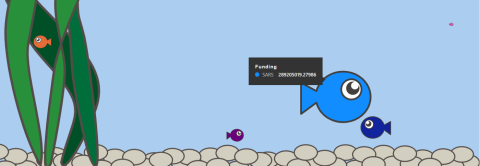Spending money on coronavirus research — but what do we spend it on?

About $0.5 billion (US dollars) has been spent by public and charitable research funders on coronavirus since year 2000. Over 90% of coronavirus research is on pre-clinical science — basically, laboratory R&D, indicating that our knowledge of all things corona is at an early stage. Funding is clearly reactive and associated with response to outbreaks (e.g. SARS and MERS), and more money has been awarded to vaccine research than on diagnostics and therapeutics.
That’s our findings. Take a look at the website.
The background

So amid the frantic efforts of everyone in response mode, there needs to be some reflection of what has gone before. That does happen, sometimes subtly and behind the scenes, or at the very least, well underneath the headlines.
One different type of number-crunching that I’ve been working on for some years is finding out how research money is spent. There are thousands of funders that support health research around the world. In global health (and here, infectious diseases) the US government (NIH), Wellcome Trust, European Commission, and Bill & Melinda Gates Foundation are among the bigger funders.
Over the last few years, within the Clinical Informatics Research Unit at the University of Southampton, UK, I’ve been leading efforts to map the global spend on all infectious disease research funding. This is part of the Research Investments in Global Health study. It’s something I started in much smaller scale in 2009 in a previous life when at UCL, and we’ve slowly expanded it ever since. Examples of previous publications and reports include analyses of malaria research funding across Africa, and the global spend on pneumonia research. We’ve presented RESIN data at the WHO, Wellcome Trust, and European Commission, among other stakeholders.
We’ve just finished putting together a $105 billion dataset across 94000 individual research awards, covering 18 years of infectious disease research funding data. Data comes from funders across countries part of the G20 (and therefore where most of the world’s money is). It’s been tedious at times, wading through thousands of spreadsheets, combining useful but imperfect algorithms with a lot of manual fine-tuning. But, eventually, we’ve got there. See the pre-print paper of the full analysis (not yet peer-reviewed)
Of that $100 billion, most of the funding comes from the USA, HIV is the most funded infectious disease by the proverbial country mile, and when you consider funding alongside the actual burden of disease, syphilis and scabies are least-well funded. In the very near future, we’ll be able to tell you how much money was spent in Ghana compared with Ethiopia compared with Chad, on what diseases, who funded it, and how that research compares with that country’s national burden of disease.
And through the mist of hefty amounts of data there is the historic funding trends related to coronavirus. Bog-standard non-famous coronavirus, plus SARS, MERS, and now all things COVID-19.
We’ll be keeping the dashboard up to date as we head through 2020 and perhaps out the other side. As we see new COVID-related funding awards being made, we’ll note them down and add them to the dashboard, and thus visualisations and data summaries will be continuously updated.
(To note, the coronavirus data has previously been shared with WHO for their internal consumption, data was presented at WHO headquarters and electronic copies sent across in February 2020)
For now, comments and criticisms are most welcome. There’s a lot of context that cannot be easily explained here, so please do ask questions. Take a look at our webpage, give the visualisation a poke and a prod and admire the fish tank, see the pre-print, look up our previous publications, and do come back later.
Our first paper is now online as a pre-print (not yet peer-reviewed)
For more information, see our website.
This blog was first published on Medium.com